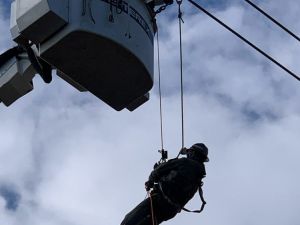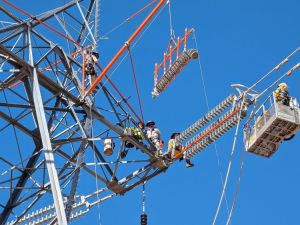Articles
5 Core Components of a Well-Developed Storm Response Plan
Electric utilities are part of the backbone of modern society, providing essential power to homes, businesses, emergency services providers and more. But this critical service is vulnerable to extreme weather events that can cause massive disruptions, damage infrastructure and jeopardize public safety. Due to the frequency and severity of such events, it is more important than ever for electric power organizations to have a comprehensive storm response plan in place.
I’ve consistently been involved in storm response planning throughout my career, both as a lineman and a safety specialist…

Variabilities in Electrical Arc Flash Protection
Accuracies are synonymous with safety and science. While many perceive that electrical safety needs to be highly exact, this article aims at creating awareness of why sticking to the basics is effective.
But before we delve into variability in electrical engineering, safe electrical work practices and electrical PPE, here is a brief story my second-year engineering physics professor shared when I was in school: A person stands in the center of a boxing ring; their soulmate stands in the corner. The person in the center is only allowed to walk toward their soulmate in discrete steps defined b…

From Risk to Reliability: Improving Rope Safety in Energized Environments
The tools and equipment employed by electrical workers must possess the necessary insulating properties to ensure user safety. One such tool, dielectric rope, can be overlooked as a component of electrical safety, but modern standards and rigorous testing protocols are transforming the way this type of rope is designed, used and maintained.
The transition from use of traditional synthetic ropes (e.g., double-braided polyester or polypropylene with wax or overlay finishes) – which can absorb contaminants and moisture, thereby significantly reducing their insulating properties – to dielectric…

Built In, Not Bolted On: Using Safety to Drive Operational Excellence
Employers in the electric utility industry are currently working on initiatives in various areas of their businesses, including safety, quality, production, leadership, and human and organizational performance (HOP). These are important programs, but it’s unlikely they’ll fully achieve their intended objectives if employees don’t have a firm grasp on how these various aspects of work impact one another – and the ideal order in which they should be addressed.
As someone who has spent a great deal of time studying HOP and teaching its principles to others, I understand that part of the philoso…
Safety By Design: Safety Management System Planning
In the first two parts of this six-part series, I discussed the importance of creating and implementing a safety management system (SMS) that actively involves all employees. This part will focus on (1) identifying and prioritizing an organization’s safety needs based on specific hazards and risks and (2) developing a plan with clear objectives and targets to meet those needs. Without a solid plan, it’s difficult to assess whether the SMS is effective and adds value to your organization.
Early in my career, I didn’t fully grasp the significance of having a safety plan. I often experimented w…
OSHA-Compliant Employee Training
“Yes, we are OSHA compliant. Our apprentice lineworkers are trained and certified by a local line school, which guarantees that the training they deliver meets OSHA standards. Every six months, we send the apprentices to the school for two weeks of hands-on training. They also take online classes in between the hands-on sessions; the online classes are delivered via a learning management system (LMS) operated by the school. It takes two years for an apprentice to complete the program. If the apprentice passes the written and practical exams delivered through the LMS, the line school then cert…
Bucket Truck Safety: OSHA Standards and Other Considerations
I receive numerous and varied questions about the safe use of bucket trucks in electric utility operations, so in this installment of “Voice of Experience,” I am going to share with you the OSHA standards you need to know as well as some things I have discovered during observations and audits of field crews.
First, it is important to recognize that there is a substantial difference between Class A barehand bucket trucks and the Class B trucks used in gloving distribution. Class A barehand trucks are used for precisely that type of work; to protect employees, OSHA requires grounding the vehic…
June-July 2025 Q&A
Q: Can you direct us to information regarding “fuzzing” or “noisy tester” voltage detectors? We’ve heard that with noisy testers, there’s potential for both false negatives (no voltage is detected although it’s present) and false positives (voltage is indicated where none exists). We’ve also heard a noisy tester can be triggered by induction on a de-energized line, creating confusion in the field. Years ago, our company stated that noisy testers shouldn’t be used. We haven’t been able to find any justification as to why the company made this decision. Can you help us out?
A: There is backing…
Prioritize Safety Now So It Becomes a Value Before It’s Too Late
We typically excel at safety – after an incident. My question is, can we get it right before an incident occurs? And if so, how? Keeping in mind that you probably learned a stove could be hot by touching one as a child, let’s consider another question: Is it possible for us to develop safety-related values or are we doomed to learn the hard way?
Take a look through the events and incidents listed below. Understanding why those individuals now use human and organizational performance (HOP) tools (e.g., checking; verification; say it out loud; event + response = outcome; step-by-step place-kee…
Recording and Analyzing Job Briefings Can Save Lives
Planning saves lives. Whether you call it a job briefing or a tailboard, taking time before work begins to identify potential hazards, discuss elimination and mitigation strategies, and align the crew reduces the risk of incidents – and it’s an OSHA requirement per 29 CFR 1910.269(c). Studies consistently show that effective planning can prevent up to 70% of workplace accidents.
But not all job briefings are created equal. Research based on 850,000 recorded safety conversations has revealed that many of these conversations fall short of their potential. The average score of these recorded…

4 Strategies to Facilitate Effective Knowledge Transfer
Effectively transferring knowledge from tenured employees to new hires and those climbing the ranks is one of the most significant challenges utility organizations must reckon with. The workforce is continuously evolving, so it is essential to ensure that valuable insights and expertise are not lost when employees leave or retire. This Tailgate Topic explores four strategies that utilities and contractors can deploy to facilitate successful knowledge transfer among employees.
1. Design and Develop a Mentorship Program
Mentorship has long been recognized as a powerful tool for knowledge sh…

Beyond the ABCs: Fall Protection for Unique Tasks
The electric transmission and distribution (T&D) industry often requires work in challenging environments. Whether crew members access tall structures by helicopter, use rope-access methods to climb lattice towers, or ride wire carts to install and maintain spacers along energized lines, their approach goes beyond standard ground-based operations. These specialized techniques can speed up projects, minimize ground disturbance – especially on protected and sensitive land – and reduce the need for site preparation (e.g., building roads).
Yet all of them present complex fall hazards.
M…

Using the Prediction Model to Prevent Incidents and Near-Misses
As someone employed in the electric utility industry, would you be willing to consider that there may be incident prevention strategies yet to be discovered and tested? Are you open to the idea that a better model could exist to create change in our industry – change that could reduce or even eliminate significant injuries and fatalities (SIFs)?
If so, I encourage you to read further.
Here’s a logical equation many of us were taught in school: If A equals B and B equals C, then A equals C. Tell me, do you believe the organization you work for takes a logical approach to workplace safety…

Making the Safety Connection: The Impact of Total Well-Being in the Workplace
Utility workers perform essential tasks that touch millions of lives every day. The critical nature of the services they provide coupled with the perilous nature of their tasks exposes these workers to life-threatening hazards. This is why the industry highly values and prioritizes safety.
Many utility companies operating today have made significant strides in improving their safety culture. Critical risk management programs and a human performance mindset have become increasingly common as organizational leaders more fully understand the link between human behavior and risk. These compani…
Safety By Design: Leadership and Employee Involvement
In the first part of this six-part series, I discussed the reasons why it’s important for utility organizations to develop safety systems that align their safety initiatives. This article will address employee involvement, an often overlooked yet fundamental component of any effective safety system.
According to ANSI/ASSP Z10, “Occupational Health and Safety Management Systems,” the phrase “employee involvement” refers to the active participation of workers in the planning, implementation, evaluation and improvement of an organization’s occupational health and safety management system (OHS…

